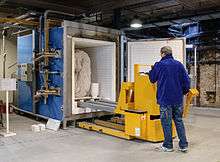Electric tug
An electric tug is a battery-powered and pedestrian-operated machine used to move heavy loads on wheels.
The machines form part of the material handling equipment industry that, amongst others, also covers fork lift trucks, overhead cranes and pallet jacks. Although ‘electric tug’ is perhaps the most commonly used term, suppliers and customers regularly use a range of other names that include towing tractors, battery-powered tugs, electric hand trucks, electric tuggers and pedestrian operated tugs. The tugs move loads across a single level. They do not lift the load clear of the ground which is why the load must be on wheels. If the load itself does not have wheels, it would be placed on a wheeled platform often referred to as a trolley, bogie or skate. The tug connects to this wheeled platform just as a fork lift truck links to a pallet in order to move a load sat on it. In most cases a steel coupling (male) attached to the machine itself connects to a corresponding coupling (female) bolted to the load’s bogie. A second bogie or multiple bogies will each have identical female couplings attached to them so that a single male coupling attached to the machine can move them all without alterations.
Operation

An electric tug relies on the principal of tractive effort. The machine, once secured to the bogie, will lift a portion of the load ensuring the load’s wheels remain on the ground. This is achieved via the machine’s hydraulic mast which is designed to create downforce on the drive wheel immediately beneath it. It is the traction generated from this process that allows the tug to move very large and heavy objects. As a tug does not lift its load clear of the ground it does not have to conform to the Lifting Operations and Lifting Equipment Regulations 1998 (LOLER), therefore an operator does not need a licence to operate it.
Applications
Electric tugs are used in many industry sectors. Some common applications include;
- Retail - To move heavy roll cages from a delivery vehicle’s tail lift to the supermarket’s storeroom or long trains of empty roll cages.
- Healthcare – To move bariatric beds, waste bins (including multiple bins at once), linen cages and gas bottles.
- Pharmaceutical – To move chromatography columns within laboratories.
- Supermarkets and Airports – To move long trains of empty luggage trolleys.
- Horticulture and Agriculture – To move heavy materials such as top soil or to harvest crops in polytunnels.
- Construction – To move heavy building materials or to access construction sites where diggers and movers cannot due to size restrictions.
- Food and beverage – To move industrial mixing bowls full of product.
- Waste handling - To move containers and waste bins and wheelie bins.[1]
- Manufacturing and Assembly-
- Automotive - To move heavy products such as vehicles down a production line.
- Glass – To move heavy stillages used to hold glass through production.
- Wind Turbines – Moving turbine blades up to 50 metres in length through production.
- Aerospace – To move wing assemblies, invar tooling, turnover jigs etc.
- Boat building – To move luxury yachts on cradles through production.
- Brick and ceramic – To move product into and out of a kiln.

- Modular buildings – To move buildings through production and completed buildings into storage.
- Cable and wire reels – To move unwieldy reels in production.
- Rail - To move loads mounted on rails, such as in railway maintenance depots.
References
- ↑ "Wheelie Bin Movers Spacepac Industries.". ev.spacepac.com.au. Retrieved 2016-09-12.